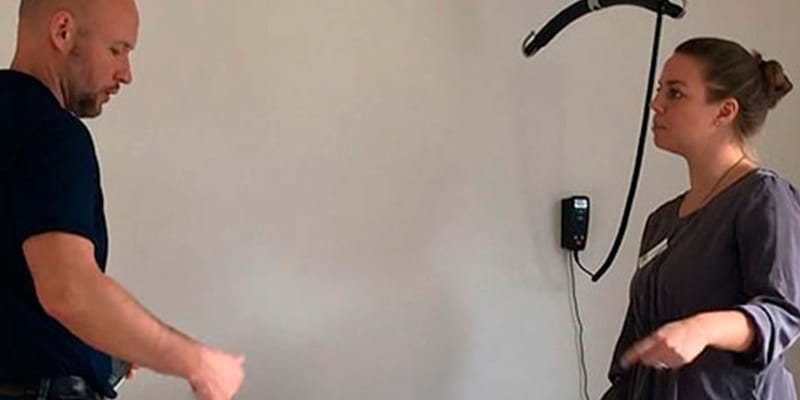
One Caregiver per Client
A project carried out in a Danish municipality has explored when it is feasible to be one caregiver rather than two in care and transfer situations. A total of 7 products were selected to be trialed in the project, including the VENDLET V5S.
14. April 2019
The Pilot Study
The project was conducted from January to March 2018, and was based on a previous pilot project also called ’One caregiver per client’. The pilot project was done at a care home with the purpose of identifying whether or not using assistive living aids in care and transfer situations could reduce the number of employees needed, i.e. was it possible to be one caregiver where you would normally be two?
The aim of the project was to:
- improve the quality of care for the clients
- improve the work health and safety for the employees
- increase overall efficiency
The project was based on the financial treaty ”Finance Agreement for Municipalities 2014”, which emphasized the application of assisted living technology. Here one of the focus areas was to optimize transfer situations. The pilot project ‘One caregiver per client’ explored, on a small scale, how the goals could be achieved, while also gathering experience for a larger scale project that took place in early 2018.
The Process
For implementation, the project received access to funds from a designated fund established by the Danish government. The funds were dedicated to purchasing assistive living aids. The project was implemented in four different care homes that each received a sum for purchasing the needed assistive living aids. In Denmark, the care homes are run by the municipalities who also purchase and allocate assistive living aids.
A total of 7 aids, including the VENDLET V5S, were tested by 27 clients in 30 transfer and care situations in which it was standard to be two caregivers. Three of the seven aids were purchased significantly more than the others, including the VENDLET system.
Time measurements were made before and after the implementation of the aids in each transfer situation such as the morning routine. The pre-measurements of time usage were made based on the normal care and transfer routine for the individual client. Post-measurements were done when the staff had become acquainted with the aids and had developed a new routine using the aid.
About the VENDLET
At the end of the pilot project, the VENDLET system was the aid the staff were most excited about. The employees who used VENDLET wanted the system to become an integrated part of everyday care.
The staff felt that the VENDLET was easy to operate and that the client experienced a higher degree of safety and were more likely to take active part when being transferred. With the use of VENDLET, there were also a better interpersonal contact between client and caregiver, as well as an overall higher quality of care. Using the VENDLET was assessed to result in:
- better work health & safety
- better comfort for the client
- better utilization of caregiver’s time.
The staff felt that VENDLET relieved them physically, particularly their backs, arms, and shoulders and that the use of VENDLET increased the quality of the care they were able to provide the clients because they were able to have better contact with the client when they were only one caregiver instead of two. The staff also estimated that using VENDLET resulted in a gentler transfer with less friction and shearing of the client’s skin, and that it consequently can help prevent tissue damage.
Increased Efficiency
The care homes experienced a clear improvement in efficiency. In 16 transfer and care situations employees managed to go from 2 to 1 caregiver, and in 12 situations it was partially possible to go from 2 to one. It was in two situations necessary to be 2 cares.
In total, the increased efficiency resulted in a 77-hour time gain per week on the 30 transfer situations that were measured. The project also calculated a net gain of 73 minutes per week, per client using VENDLET.
In addition, implementation of the project has meant that it is now possible to be one caregiver rather than two in many more situations. This also saved time.
Improvements for Staff and Client
There was broad consensus that the most positive outcome of the project was the increased flexibility in planning caregiver’s work, improved work health and safety for employees, and improved quality of care for the clients.
VENDLET was especially emphasized by the staff, as it relieved them from straining their shoulders, wrists and backs. Going from two to one employee also resulted in greater flexibility in the caregiver’s routines, as they were no longer dependent on each other, which reduced waiting time.
Clients also experienced better quality in transfer and care situations. In particular, the clients felt more involved in the transfer and therefore were more active themselves. This strengthens the client’s independence while also contributing to their physical and mental rehabilitation.
In addition, the clients were pleased that there was only one carer to talk to and that the conversation was between the client themselves and the caregiver, rather than between the two caregivers.
It has surprised the employees that being one caregiver rather than two has resulted in so much more quality for the client. The project has also meant that the employees who participated in the project became more aware of involving the client in transfer and care situations.
It is the project group’s assessment that there are even more clients who can go from two to one carer in transfer and care situations. This will mean additional time savings and better quality of care.
Download PDF:
Report from Hillerød Municipality: Afslutningsrapport for Projekt Én omkring borgeren (Danish)
